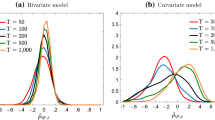Abstract
Structural time series models applied to the factor inputs of a production function often lead to small output gaps and to erratic measures of potential growth. We introduce a dual cycle model which is an extension to the multivariate trend plus cycle model with phase shifts à la Rünstler. The dual cycle model is a combination of two types of model: the trend plus cycle model and the cyclical trend model, where the cycle appears in the growth rate of a variable. This property enables hysteresis to be taken into account. Hysteresis is likely to show up in unemployment, but it can also affect the capital stock due to the existence of long investment cycles. In the proposed model, hysteresis may affect all the factor inputs of the production function and phase shifts are extended to the dual cycles. Genuine measures of potential growth can be computed that are hysteresis-free and less prone to volatility. A complementary measure of the output gap that takes hysteresis into account can be derived.
Similar content being viewed by others
References
Altissimo F, Bassanetti A, Cristadoro R, Forni M, Hallin M, Lippi M, Reichlin L (2001) EuroCOIN: a real time coincident indicator of the euro area business cycle. CEPR Working Paper 3108
Blanchard O, Summers L (1987) Hysteresis in unemployment. Eur Econ Rev 31(1–2): 288–295
Doménech R, Gómez V (2006) Estimating potential output, core inflation, and the NAIRU as latent variables. J Bus Econ Stat 24(3): 354–365. doi:10.1198/073500105000000315
Doornik J (1998) Object-oriented matrix programming using Ox 2.0. Timberlake Consultants Press, London
Doornik J, Hansen H (2008) An Omnibus test for univariate and multivariate normality. Oxf Bull Econ Stat 70: 927–939
Fiorentini G, Planas C, Rossi A (2008) The marginal likelihood of structural time series models, with application to the US and the euro area NAIRU. Rimini Centre for Economic Analysis Working Paper 21-08
Harding D, Pagan A (2005) A suggested framework for classifying the modes of cycle research. J Appl Econom 20: 151–159
Harvey A (1989) Forecasting, structural time series models and the Kalman filter. Cambridge University Press, Cambridge
Harvey A, Koopman S (1997) Multivariate structural time series models. In: Heij C, Schumacher J, Hanzon B, Praagman C (eds) System dynamics and financial models. Wiley, Chichester, pp 269–298
Jaeger A, Parkinson M (1990) Testing for hysteresis in unemployment, an unobserved components approach. Empir Econ 15(2): 185–198
Jaeger A, Parkinson M (1994) Some evidence on hysteresis in unemployment rates. Eur Econ Rev 38: 329–342
Koopman S, Harvey A, Doornik J, Shephard N (1995) Stamp, structural time series analyser, modeller and predictor. Timberlake Consultants, London
Koopman S, Shephard N, Doornik J (1998) Statistical algorithms for models in state space using SsfPack 2.2. Econom J 1: 1–55
Moës P (2006) The production function approach to the Belgian output gap. Estimation of a multivariate structural time series model. Bruss Econ Rev 49(1): 59–89
Morley J, Nelson C, Zivot E (2003) Why are Beveridge-Nelson and unobserved component decomposition of GDP so different. Rev Econ Stat 85: 235–243
Oh K, Zivot E (2006) The Clark model with correlated components. University of Washington Department of Economics Working Paper 16
Perron P, Wada T (2009) Let’s take a break, trends and cycles in US real GDP. J Monet Econ 56: 749–765
Proietti T (2006) Trend-cycle decompositions with correlated components. Econom Rev 25: 61–84
Proietti T, Musso A (2007) Growth accounting for the Euro area—a structural approach. ECB Working Paper 804
Proietti T, Musso A, Westermann T (2007) Estimating potential output and the output gap for the euro area: a model-based production function approach. Empir Econ 33: 85–113
Rünstler G (2004) Modelling phase shifts among stochastic cycles. Econom J 7: 232–248
Sinclair T (2009a) The relationship between permanent and transitory movements in U.S. output and the unemployment rate. J Money Credit Bank 4: 529–542
Sinclair T (2009b) Asymmetry in the business cycle: Friedman’s plucking model with correlated innovations. Stud Nonlinear Dyn Econom 14(1): article 3
Author information
Authors and Affiliations
Corresponding author
Additional information
The views expressed in this paper are those of the author and do not necessarily reflect the views of the National Bank of Belgium.
Rights and permissions
About this article
Cite this article
Moës, P. Multivariate models with dual cycles: implications for output gap and potential growth measurement. Empir Econ 42, 791–818 (2012). https://doi.org/10.1007/s00181-011-0454-3
Received:
Accepted:
Published:
Issue Date:
DOI: https://doi.org/10.1007/s00181-011-0454-3



